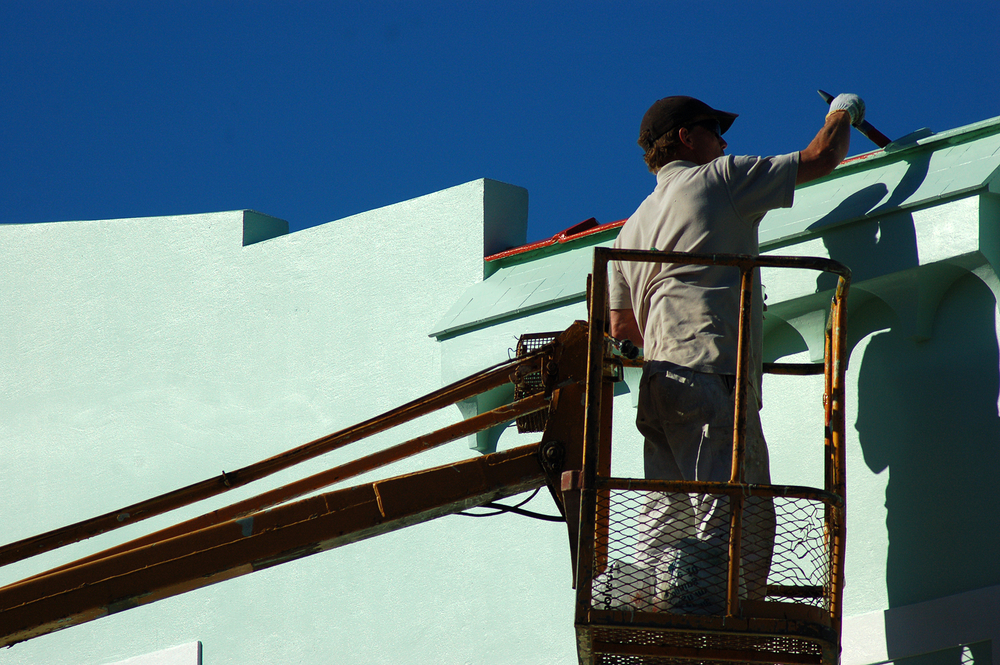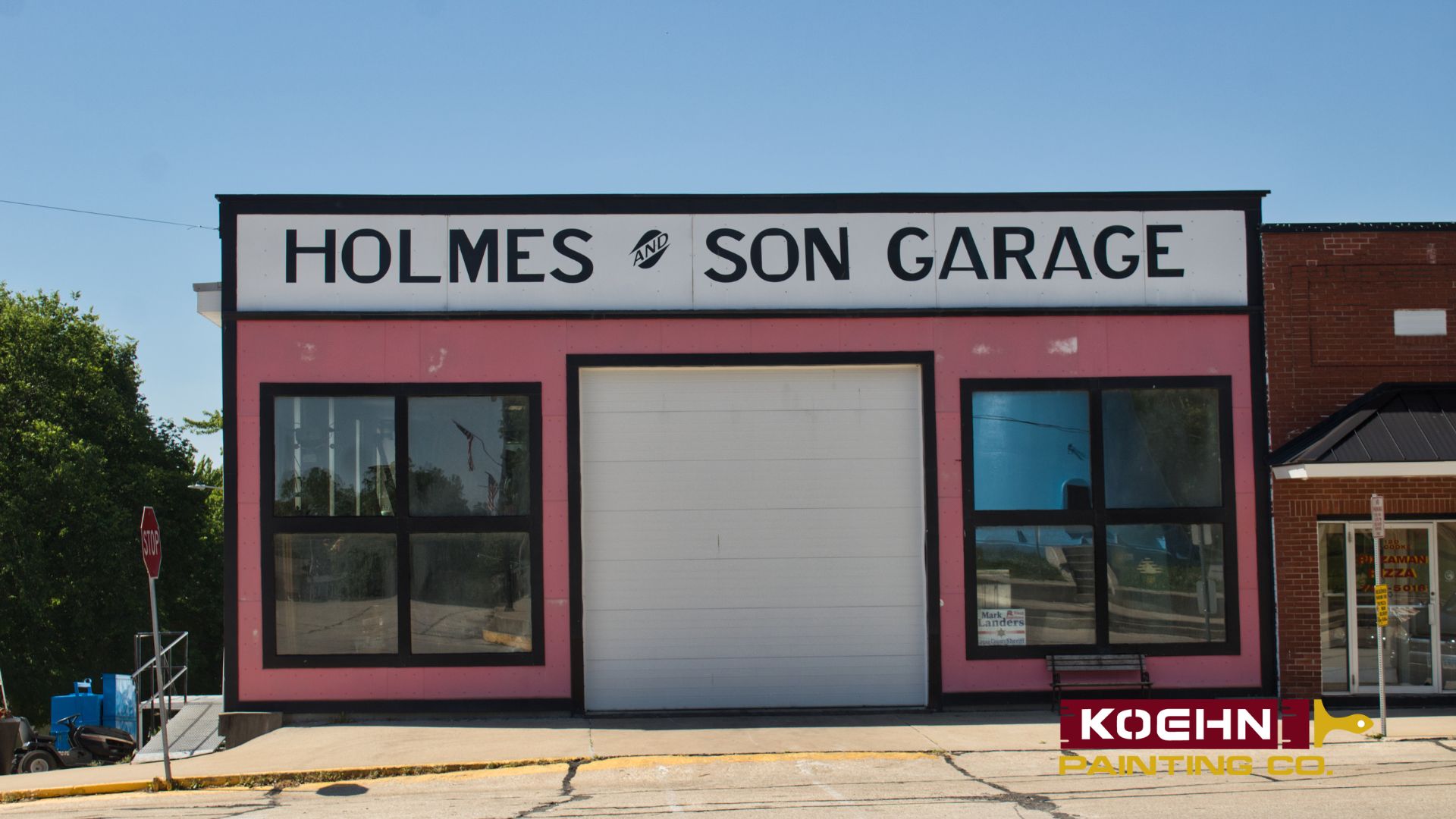Table of Contents
ToggleCommercial property painting is much more than a cosmetic element. It plays an essential role in building maintenance and can even improve a space’s functionality, value, and general appeal. These are especially crucial for boosting business success. The more functional and appealing a business is (especially to customers), the more likely it is to drive profits and retain clients.
A business’s building’s exterior and interior condition sends a clear message about the business itself. Professional commercial property painting can help business owners leverage the look of their space to have that associated message be as impactful as possible. That impact can help a business in many ways.
Key Benefits of Commercial Property Painting
When business owners consider commercial property painting, they should recognize its numerous benefits. Grasping the key advantages of commercial property painting is the initial step in the painting process. This ensures that the business owner understands the potential value of their investment before they become deeply involved in the process. Below are some insights into the main benefits of commercial property painting.
1. Enhance Curb Appeal and Attract Clients
People judge based on appearances; that is a simple fact of life. And for a business, this can mean the difference between winning and losing customers. The outside of a business is the first thing people see, so it should attract and introduce them to the company in some capacity.
Potential clients can draw conclusions about a business and its values based on its exterior before entering the place and engaging with what the business offers. This means that before a company can sell itself based on products and services, it needs to be able to sell itself based on looks.
Commercial property painting can help create a clean and welcoming vibe to entice potential customers. When a paint job is fresh and well-maintained, it conveys that a business cares about being put together and is well-managed and looked after (i.e., a sense of professionalism). A new look can also help a business stand apart from others, especially if it is located in a crowded area surrounded by competition.
- Color choices matter: The colors chosen in a business space are an integral tool for messaging. Choosing the right colors can help a brand be instantly recognizable and even communicate something about the brand’s goals and values.
- Professional appearance: A business with faded and peeling paint can come across as outdated and neglected, which is the opposite of where one wants to be in the competitive business landscape. Keeping company spaces fresh and polished with commercial property painting communicates that the brand is successful and trustworthy, naturally attracting client interest.
2. Protect the Building from Weathering and Wear
One of the most practical reasons for commercial property painting is protection. This is especially necessary in areas with more extreme weather patterns. The natural elements can harm a building over time through exposure to UV rays, rain, snow, and temperature fluctuations. Paint can actually be a protective barrier that helps prevent moisture damage, cracking, and general deterioration so that a building can last even longer.
- Moisture protection: Water from rain or other natural sources can seep into walls and cause structural damage, leading to a build-up of mold and mildew. Paint protects against this.
- Sun protection: Long-term exposure to UV rays is a leading cause of cracked, faded, and degraded building exteriors. Thankfully, high-quality paints preserve buildings by blocking the damaging rays.
- Weather resistance: Buildings aren’t only damaged by heat and moisture; they can also be negatively impacted by temperature and weather fluctuations. These fluctuations can cause buildings to expand and contract, eventually leading to cracks and other weaknesses in the structure. However, paint helps buildings fight against these rapid fluctuations.
3. Improve Energy Efficiency with Reflective Coatings
Exterior paint can protect a building and improve its energy efficiency. For example, reflective coatings specifically made for energy efficiency reflect sunlight to reduce heat absorption. Even simply using light-colored paints can help reduce heat and keep indoor temperatures comfortable while promoting cost-effectiveness through lowered cooling prices.
- Reducing heat absorption: Buildings can attract heat, especially ones that are made of concrete and happen to be in especially hot areas. Light-colored paints or reflective coatings bounce sunlight away from buildings so that less heat is absorbed into the structure.
- Lower energy costs: Because of less heat absorption, cooling systems like HVAC are used less often and don’t have to work as hard to cool the building, leading to reduced energy bills.
- Environmentally friendly: This all has the combined effect of making a building (and, by extension, the business it houses) more sustainable because the property consumes less energy.
4. Boost Property Value and Brand Image
A building that’s in good condition will naturally have a higher resale value than one that looks as though it could fall apart at any moment. Commercial property painting is key to improving a building’s condition and boosting its market value.
This is beneficial for any business aiming to sell or lease its property. Just as a fresh coat of paint can draw in customers, it can also attract potential buyers. Maintaining paint jobs demonstrates a level of pride and care in one’s business that can influence brand perception.
- Attracts potential buyers/tenants: People will be far more interested in a building that appeals to them and looks to be worth the investment.
- Increases resale value: If a building looks new and well-maintained, buyers or renters may be willing to pay a higher market price for it.
- Reflects brand values: Keeping a paint job fresh requires consistent care and attention to detail, both of which are key aspects of professionalism that clients can pick up on just based on appearances.
Key Considerations When Painting Commercial Properties
Once a business owner fully understands how commercial property painting can affect business success, they can begin to consider some of the practicalities of the painting process. While this might seem like tedious information that one should leave to the professionals, knowing the information for oneself ensures that one is fully prepared when deciding to contract a professional commercial painter.
So, while painting commercial properties is all about the enjoyable end results, the overall process involves more than just choosing the right colors; it requires detailed planning, adherence to regulations, and strategies to minimize disruption to regular business operations. For the job to proceed as smoothly as possible, all parties must keep the following in mind:
Adhering to Building Codes and Regulations
Before starting any commercial painting project, it’s crucial to ensure that the work complies with local building codes and regulations. These can vary between cities and regions. Some may have specific requirements for paint types, color choices, and other factors like environmental impact or historical preservation. Knowing these rules before the project begins ensures they will be followed to avoid delays, fines, or legal issues.
- Zoning and permits: These may be needed for buildings located in historic districts and other protected areas, so the proper permits should be obtained before any part of the project begins.
- Environmental regulations: As the world becomes more environmentally conscious, more areas are requiring eco-friendly and non-toxic paints with low volatile organic compounds (VOCs). Local laws concerning paint emissions should be consulted beforehand.
- Code compliance: Codes like fire safety regulations should be complied with to protect the safety of everyone (workers in particular) in the painting project zone, especially in high-rise buildings or industrial properties.
Minimizing Disruption to Business Operations
One of the biggest challenges when painting commercial properties is minimizing disruption to daily business operations. Like any other kind of construction job, painting can be loud, busy, and messy. In all the hustle and bustle of painters working around the space, the last thing any business owner wants is for this to deter customers or distract employees from doing their work efficiently. However, experienced commercial property painting services know what strategies to employ to reduce their work’s impact on a business.
- Schedule strategically: Instead of having painters present and working throughout the business’s active hours, the paint job can be scheduled during off-hours, weekends, or slow business periods. This way, there are no disturbances to employees and clients.
- Work in phases: This is a great tactic for larger business spaces. The painters can work in sections of the building bit by bit until the whole paint job is complete. This leaves most of the building functional and accessible throughout the painting process.
- Low-odor paints: To keep the air clean and breathable throughout the painting project, professionals should use low-VOC and quick-drying paints.
- Communication is key: Anyone who regularly interacts with the building (clients, employees, etc.) should be informed of the schedule before the painting project begins so that they can prepare for potential disruptions and work around them.
Selecting Eco-Friendly and Durable Materials
Commercial property painting professionals should use high-quality materials throughout the process, including durable and eco-friendly ones. High-quality paint is necessary in commercial spaces, which are high-traffic areas that experience a lot of wear and tear, and eco-friendly materials help keep the building healthy for everyone.
- Eco-friendly paints: These are low-VOC or zero-VOC paints that improve indoor air quality. They are critical in commercial spaces, especially those in healthcare or food-related industries.
- Durability: Unlike residential spaces, commercial spaces are high-traffic areas and, as such, should be painted with durable materials that can resist staining, fading, cracking, chipping, peeling, and other forms of damage.
- Cost-effectiveness: Eco-friendly and durable paints save money in the long run because an initial investment in them lasts longer than a cheaper investment in lower-quality products that would require costly and frequent maintenance.
What to Know Before Hiring a Commercial Painting Service

Having a thorough understanding of why commercial property painting matters in the first place is essential to deciding whether or not it is worth the time and investment. The key benefits lead to long-term business success, making the process one of a high value. If a business owner is interested in taking the next steps, there are a few details they should come prepared with before they approach a company that provides a commercial painting service.
While a painting professional can offer their prospective client guidance on the most effective color options, the painting process as a whole, and what the price of commercial painting takes into account, the client should still take the initiative to inform themselves on these matters before consulting with the commercial painting service. Being informed on the topics below would allow communication between both parties to be as open and efficient as possible.
Top Exterior Paint Colors for Commercial Properties
By this point, it is clear that choosing an exterior paint color is a decision with a lot of influence and should be approached as such. The decision-making process should involve strategy to ensure alignment with industry trends, business identity, and aesthetic appeal. This ensures a strong approach to selecting the best exterior paint colors for a commercial building.
Trending Color Palettes for Different Industries
There will always be those classic colors that can work for spaces across functions and industries. However, choosing an optimal color is all about understanding what hues work best for each specific type of business and how a brand wants to portray itself. For example:
- Retail and Hospitality: Businesses in these industries need to be able to draw the eye and make people feel welcome. Bright, bold colors like vibrant reds, oranges, or yellows suit this purpose ideally.
- Corporate Offices: These spaces need to foster a sense of calm to increase focus and productivity. Neutral tones such as soft grays, blues, and whites create a clean look that contributes to that necessary professional environment.
- Healthcare Facilities: Calm and focus are even more essential in healthcare facilities for both clients and staff. Soothing cool tones like greens and light blues evoke this sense of calm.
- Restaurants and Cafes: These are spaces where people want to feel relaxed and comfortable enough to enjoy a meal or just to sit and chat with a friend. Earthy hues such as browns, muted greens, and warm reds create a cozy and inviting space for diners.
How to Align Colors with Brand Identity
To help a building’s exterior reflect the brand’s personality, one should consider more than just a singular color. Instead, a palette of complementary colors can be an even stronger means of fully capturing a company’s core values and messaging to reinforce brand identity. For example:
- Bold and Energetic Brands: Highly saturated colors, such as bright red or orange, can convey confidence, passion, and energy. For example, Red Bull’s logo uses bright red, yellow, and electric blue to emphasize the product’s purpose as an energy drink.
- Professional and Trustworthy Brands: Cooler tones, like navy blue or charcoal gray, convey stability, professionalism, and reliability. For example, Visa’s simple navy blue logo boosts its trustworthiness and professionalism as a payment card service.
- Creative and Innovative Brands: Going for more playful colors like purple, teal, or even pastel hues can help a business stand out and convey a certain level of creativity. For example, For example, Google’s iconic logo is unconventional because it uses four different colors (red, blue, yellow, and green).
Tips for Creating a Welcoming and Professional Aesthetic
Hiring a commercial painting service to paint a business’s exterior involves more than simply covering the entire building in a single color. A commercial property’s exterior paint aims to create an inviting, professional appearance that attracts the target audience. This process requires certain considerations:
- Contrast is key: Everyone wants their building to stand out, but there is also such a thing as an eyesore. Complementary colors are the way to make a building stand out without being over the top.
- Remember the trim: While the main color of the building is the most important part, the color of the trim should also be carefully considered. Contrasting colors between the building and the trim, such as dark blue trim on a pastel yellow building, can add depth and even highlight architectural features.
- Consider the surrounding environment: While a business should stand out from others, it should also match the general colors of the surrounding landscape, striking a delicate balance.
The Commercial Painting Process: What to Expect
Knowing the latest exterior paint trends and how to choose a color with an informed strategy will make the process even easier once a business owner is ready to meet with a commercial painting service provider. However, choosing a color is a small part of the painting process. Commercial painting involves several key steps, from initial preparation to post-painting care, and people should have a clear idea of what to expect.
Prepping the Building: Cleaning, Repairs, and Priming
Before paint even hits a surface, it should be thoroughly prepared so that the paint can be applied to a clean surface and adhere well for final results that are as smooth and long-lasting as possible. Surface prep typically involves:
- Cleaning the exterior: A client can either have their commercial painting service handle this or do as much as they can on their own. Many professional painting services also offer pressure washing services, which use tools to remove dirt, grime, and old paint that could prevent the new paint from adhering.
- Repairs: Cracks, holes, or damaged surfaces make walls uneven and can result in messy final results. So, they are patched up before painting to create a smooth, even surface.
- Priming: This is a key way to ensure high-quality final results. Applying a primer helps paint bond properly to surfaces, especially wood or metal.
Application Methods: Spraying, Rolling, and Brushing
The method of applying paint changes according to the size of the building and the type of area being painted. Each application method has benefits and drawbacks, making it suited for some places and bad for others.
- Spraying: This method is Ideal for large buildings because it can quickly cover a lot of surface area in a smooth, even coat. However, it also requires careful control to avoid overspray.
- Rolling: This method is much more precise and consistent than spraying, so it works best in smaller areas or on intricate details.
- Brushing: This method is used the least to fully cover large surface areas like walls. Brushes work best for touch-ups or smaller details because they give the painter more control.
Post-Painting Care and Final Inspections
After the painting is completed, the painting project is not yet done. There still needs to be a final inspection with the client and the commercial painting service to check that everything has been done to everyone’s satisfaction. Post-painting care includes:
- Touch-ups: The professional painters might notice areas or imperfections they missed during the job and address them.
- Cleaning up: Of course, the area of the job site must be cleaned to remove any leftover supplies, paint splatters, or equipment that would get in the way of normal business operations.
- Final inspection: The client and the painting company do a final walk-through together to ensure that the paint job meets the client’s expectations and everything is good to go.
Contact us here if you would like to find the best painting contractor for your residential or commercial painting needs.
The Role of Maintenance in Commercial Building Exterior Painting

All the aforementioned information is essential knowledge before and during the commercial building exterior painting process. But what happens afterward? Once commercial property painting is complete, regular maintenance is still necessary. This aspect of the process should not be neglected; it ensures the paint job lasts and continues to protect the property over time. Maintenance keeps a building looking and functioning at its best through the following procedures:
Routine Cleaning and Inspections
Routine cleaning is crucial to maintaining the appearance and longevity of commercial building exterior painting. Dirt and grime can degrade paint over time, and regularly washing surfaces removes these pollutants. For areas where paint is already starting to degrade, like peeling and cracking, regular inspections are critical in catching these damages early on so that they can be repaired as soon as possible before the issues spread.
- Pressure washing: Businesses can use a gentle pressure washer or a simple wipe with a gentle cleaning product to remove dirt buildup without damaging the paint.
- Check for damage: They should also perform routine inspections of the paint for cracks, peeling, or fading to address these issues early and prevent further damage.
Touch-ups and Repainting Schedules
Even with all these preventative measures, commercial building exterior painting can still show signs of wear and tear over time. This is why touch-ups should be done with regularity. They are a simple but effective way to maintain appearances and keep buildings functioning well.
- Repainting intervals: Every property has different painting needs based on factors like size, area usage, and damage from the elements. For example, exteriors in high-traffic areas typically need a repaint every three to seven years. Business owners should create a painting schedule based on their property’s needs.
- Touch-up paint: When the commercial painting service cleans up its equipment, it can be wise to keep some extra paint for small repairs, such as addressing areas that have been scratched or damaged.
Partnering with Contractors for Ongoing Maintenance
If business owners find regular maintenance challenging, they can seek expert guidance by working with a professional commercial building exterior painting contractor, perhaps even the same company that did the original paint job. Professional painters can advise on maintenance schedules, what paint types work best for the building, and how to protect the space.
- Regular check-ins: Contractors know when are the best times to schedule routine inspections and touch-ups as part of a long-term maintenance plan.
- Expert advice: If the business owner has any concerns, a painting professional can provide other maintenance recommendations in addition to inspections and scheduling.
Finding the Best Commercial Property Painting Service For You

Covering all the details of the commercial property painting process should make any business owner want to jump at the opportunity to invest in their company’s success. But before they get too caught up in colors and painting contractors, they should consider what they can afford for the project itself and their paint contractor.
When planning a commercial painting project, understanding the associated costs is crucial for managing one’s budget. Anyone undertaking a commercial painting project should have a clear idea of their objectives, particularly regarding the project’s overall scope and complexity.
These are two of several factors that influence the price of commercial property painting. Below are a few more:
Factors Influencing the Price: Size, Materials, Labor, and Complexity
Several key elements determine the overall cost of a painting project:
- Size of the building: Of course, the bigger a building is, the more painting materials and manual labor will be required to do the job efficiently, making it more expensive.
- Materials: High-quality premium and eco-friendly paints are more cost-effective because they ensure that results have a better finish and longevity with less costly maintenance. But they are still a more expensive initial investment than lower-quality options.
- Labor: The more experienced professional painters will charge higher rates for their expertise because they ensure high-quality, long-lasting results.
- The complexity of the job: Buildings with intricate details, such as tall windows or multiple stories, take more time to paint and need specialized equipment, increasing the cost.
Average Costs for Exterior vs. Interior Projects
Exterior surfaces need materials that can fight against the weather and natural elements, so they tend to be more expensive. The outside of a building also has more surface area to cover, especially if professional painters face the challenge of working at height. On average:
- Exterior painting costs anywhere from $2 to $6 per square foot.
- Interior painting averages $1.50 to $4 per square foot.
How to Budget Effectively for a Painting Project
An effectively managed commercial property painting budget should involve the following steps:
- Get multiple quotes: One should never settle for the very first painting contractor one comes across. Instead, have a pool of companies that best suit the project and approach each of them. Compare their offers to get the best value for one’s money.
- Set aside a contingency fund: With any project as extensive as painting commercial property, it is important to plan for the unexpected. Unanticipated repairs or extra coats of paint may be necessary, and having extra funds will help cover these costs.
- Plan for long-term maintenance. Of course, regular repainting will be a future recurring expense. Planning for maintenance in the initial commercial property painting budget makes the process easier.
How to Choose the Right Commercial Painting Contractor
After budgetary concerns have been addressed, the business owner can move on to the step that really commits them to the commercial property painting process: selecting the right commercial painting contractor for their needs. Not all commercial painting contractors, no matter how reputable, might be well-suited for a particular job.
This selection process is crucial to ensuring the painting project goes smoothly and delivers the best results. Whether the project involves painting exterior or interior commercial property, it’s important to work with a professional who exceeds expectations. Knowing exactly what to look for throughout the hiring process makes all the difference.
Key Qualities to Look for (Experience, Certifications, References)
When evaluating contractors, experience, certifications, and references are critical and should be prioritized.
- Experience: The contractor should not only have proof of extensive experience in commercial painting, but they should also have experience dealing with properties that are very similar to their prospective clients in size, scope, and complexity.
- Certifications: They should also have the necessary licenses, insurance, and certifications to meet industry standards and maintain safety and professionalism on the work site.
- References: Every reputable commercial property painting professional has references or case studies from past clients to provide examples of completed projects and testimonials from satisfied customers.
Importance of a Detailed Project Proposal and Timeline
A strong project proposal and timeline prepare all parties for surprises and help the prospective painting client make informed decisions. A reputable painting contractor will provide a comprehensive project proposal that includes details such as:
- Scope of work: This would be a clear and detailed outline of the work that the painting project encompasses, including surface preparation, application methods, and materials.
- Timeline: Contractors should also give a realistic timeline with key milestones and completion dates. This helps to keep everyone on schedule so that the work is completed efficiently.
- Cost breakdown: They should also provide an estimate that details all costs, including a breakdown of the costs of labor, materials, and any potential extra charges.
Questions to Ask Before Hiring
Asking questions is another important step in assessing a contractor’s qualifications, reliability, and suitability for the project. Before signing a contract with a commercial property painting contractor, it can be helpful to ask them the following questions:
- What experience do you have with commercial properties?
- Do you have liability insurance and workers’ compensation coverage?
- What type of paint and materials do you recommend for my property?
- Can you provide a detailed project timeline and breakdown of costs?
- Will you provide a warranty for your work?
All in all, Investing in commercial property painting is a strategic way to give a business a competitive advantage. It enhances curb appeal, protects the building, improves energy efficiency, and increases property value. A fresh paint job can even contribute to a professional environment that invites customers and has a positive influence on employees.
From selecting the ideal colors to hiring a qualified painting contractor, every step of the process is crucial in ensuring the best long-lasting results. By keeping on top of maintenance and using high-quality materials in the painting process, business owners can protect their investment and help their property withstand time and nature.
Business owners might be interested in giving their building’s exterior a new look, keeping the interior polished, or finding the right contractor for the job. Whatever the case, commercial property painting is well worth the investment due to its long-term benefits. The knowledge above helps with informed decisions, enabling one to confidently take the next step in transforming and maintaining one’s commercial space.
Discover the Koehn Painting difference – contact us today for a free estimate and step into a vibrant, freshly painted home!





